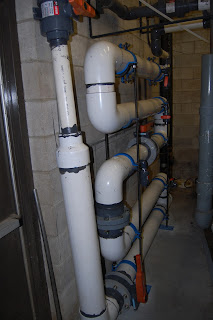The current sampling panel was not working properly, in fact it had never worked properly due to insufficient flow through the sample coolers.
While all this construction was going on the paper mill decided to upgrade the existing sample cooler panels as well as install the proper ones for the new plant.
The samples to be cooled were from the high pressure boilers, feed water, condensate, superheaters, and steam lines.
Some of the tests were for Silica, Dissolved Oxygen, and all other related tests for the water treatment.
We designed panels with multiple sample coolers on each panel.
Each sample cooler panel had a common inlet and discharge for the cooling water.
 |
| Panel showing common inlet and discharge |
Each sample cooler was constructed with Stainless Steel internals and externals. Each cooling coil had 20' of Stainless Steel tubing and each shell was extended for a greater cooling area.
 |
| Stainless steel sample cooler internals |
 |
| Discharge showing stainless steel braided hose to header |
Each sample cooler was valved to be independent with valves, and each connection was attached utilizing Stainless braided hose with Teflon internals and/or Stainless steel unions.
Space was a concern so the coolers were staggered on the panel for a smaller footprint.
 |
| Inlet with valves and stainless steel braided hose |
This accommodated the site requirements for size without restricting the cooling capacity of the sample coolers.
The Stainless Steel drip pan at the bottom of the panel will be used to catch and send to drain all samples not actually being used in the process.
 |
| Stainless steel drip pan |
 |
| Top view of the sample cooler panel |
Here are the panels to be put in place for the new facility as well as the upgrade of the existing sample cooler panel.













































